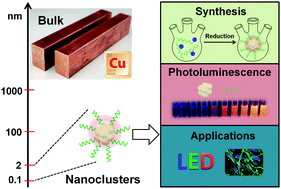Synthesis, optical properties and applications of light-emitting copper nanoclusters
Abstract
Metal nanoclusters (NCs) containing a few to a few hundreds of atoms bridge the gap between nanoparticles and molecular compounds. The last decade evidenced impressive developments of noble metal NCs such as Au and Ag. Copper is an earth abundant, inexpensive metal from the same group of the periodic table, which is increasingly coming into focus for NC research. This review specifically addresses wet chemical synthesis methods, optical properties and some emerging applications of Cu NCs. As surface protecting templates/ligands play an important role in the stability and properties of Cu NCs, we classified the synthetic methods by the nature of the capping agents. The optical properties of Cu NCs are discussed from the point of view of the effects of the metal core, surface ligands and environment (solvents and aggregation) on the emission of the clusters. Applications of luminescent Cu NCs in biological imaging and light emitting devices are considered.

- This article is part of the themed collection: Nanoscale Horizons 10th anniversary regional spotlight collection: China


 Please wait while we load your content...
Please wait while we load your content...